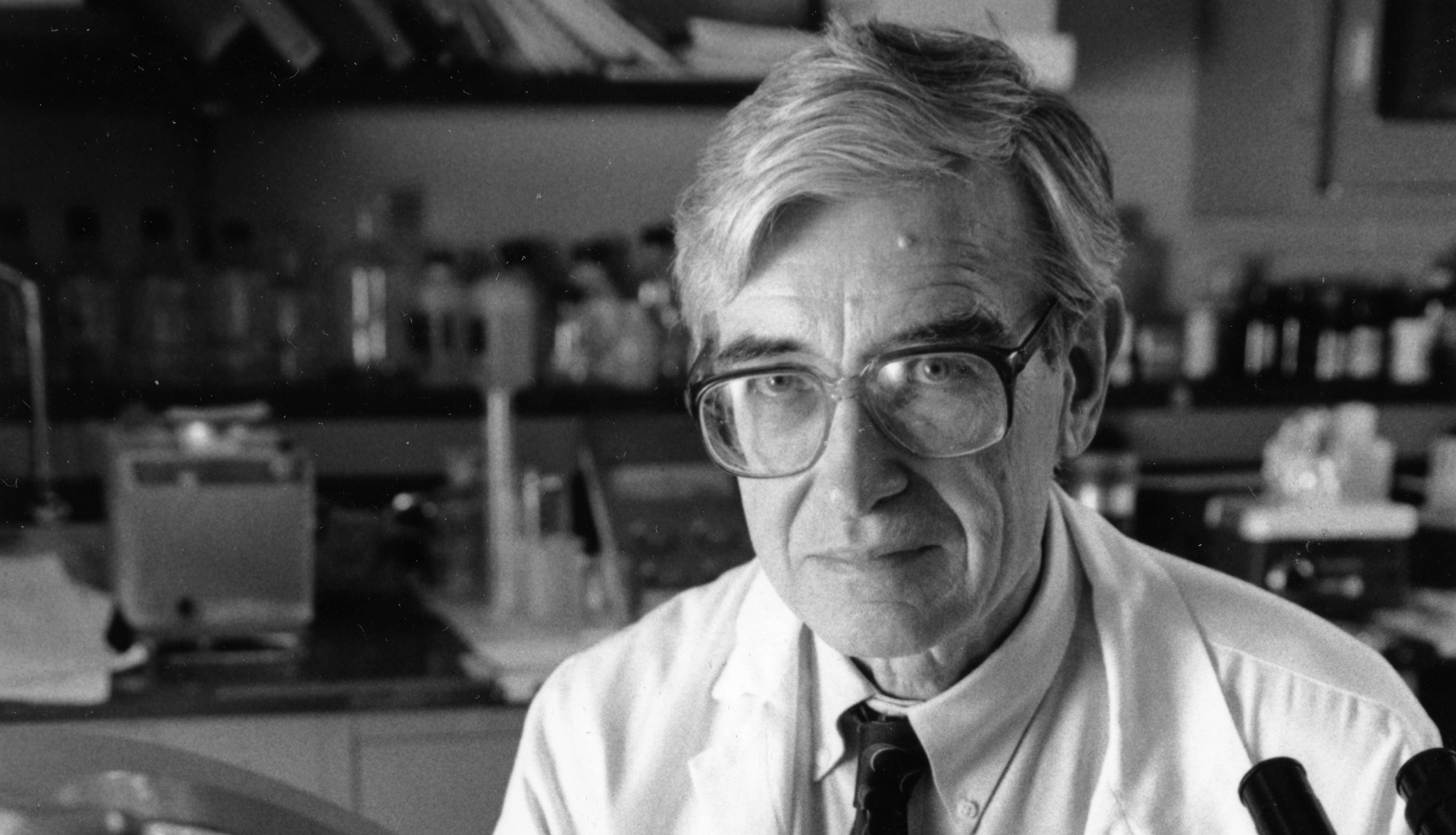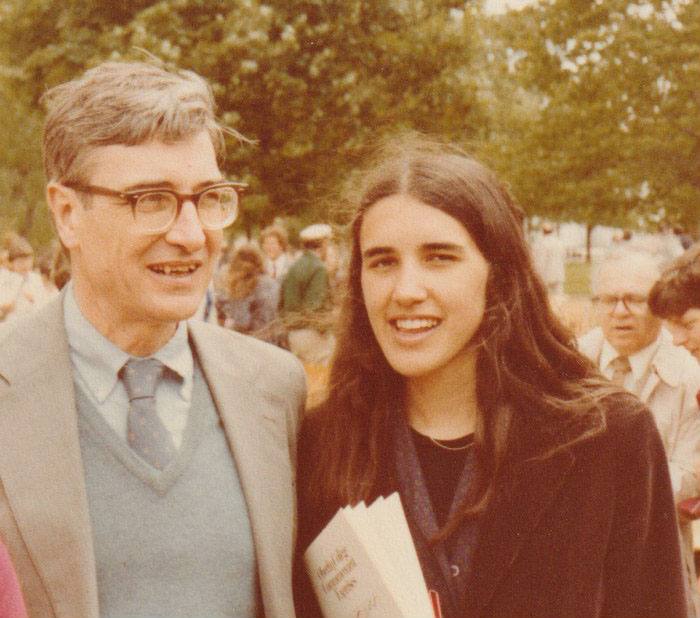
UChicago neuroscientist and pediatric neurologist Peter Huttenlocher’s research gained broader recognition in the final years of his life and after his death in 2013. (Photography by Matthew Gilson, UChicago Photographic Archive, apf1-12373, Hanna Holborn Gray Special Collections Research Center, University of Chicago Library)
In writing about her father’s life, Anna Huttenlocher, LAB’79, saw links between his work in pediatric neurology and his traumatic childhood in Nazi Germany.
When Peter Huttenlocher was a boy growing up in Germany in the years just before World War II, his mother openly defied the Nazis and had to flee the country. Only 6 years old, he would not see her again for more than a decade. From there, his was a childhood of moving, hiding, going hungry, and witnessing horrors.
Huttenlocher, who died in 2013, rarely spoke of these painful memories, says his daughter Anna Huttenlocher, LAB’79. But they unquestionably drove his life’s work. Peter became a pioneering University of Chicago neuroscientist and pediatric neurologist who, in 1979, discovered “synaptic pruning,” the process of synapse elimination in the developing brain.
Though it had been well established that the brain’s synaptic connections increase dramatically during early childhood, Peter was the first to determine that millions of these connections are subsequently eliminated as children grow and learn. That streamlining, or pruning, of little-used neurons and synapses begins in early childhood and coincides with key developmental milestones, such as learning to walk or speak, Anna writes.
In her book, From Loss to Memory: Behind the Discovery of Synaptic Pruning (Cambridge University Press, 2023), Anna chronicles her father’s remarkable life as a physician-scientist, connecting the dots between the childhood trauma he kept hidden and a career marked not only by groundbreaking research but by fierce advocacy for his young patients. “He had an understanding of childhood suffering that was more than most people,” she says. “He was very focused on moral issues—what makes people do good things and bad things.”

Though initially received with skepticism, her father’s discovery made a lasting impact on the understanding of early childhood education and the early introduction of subjects, like musical training and second-language acquisition, to capitalize on periods of optimal neural plasticity. “It was this whole idea that there are these windows” of opportunity, she says, a concept now considered foundational.
Peter had his own window of opportunity in December 1948 when, at nearly 18, he reunited with his mother in Buffalo, New York, and began a new life. He quickly learned English, then motored through his studies in philosophy and premedicine at the University of Buffalo, graduating in three years.
While in college, Peter met his wife, Janellen Burns, whose career as a cognitive psychologist would flourish alongside his. Both completed graduate degrees at Harvard and, after teaching at Yale and Columbia, respectively, they moved to the University of Chicago in 1974, where Janellen had been offered a position in the Department of Psychology (at the time of her death in 2016, Janellen Huttenlocher was the William S. Gray Professor Emeritus in Psychology). Peter joined the School of Medicine faculty the same year as a professor of pediatrics, later adding neurology.
From the time he arrived at the University, Peter spent countless solitary hours imaging synapses with an electron microscope. But being “kind of a caregiver,” his daughter says, he was also drawn to the clinical side of his work, warmly engaging with and advocating for his patients. In From Loss to Memory a former student, the 2011 Nobel Prize winner Bruce Beutler, MD’81, recalls how Peter sat at the bedside of a patient afflicted with Reye’s syndrome, a brain condition linked with aspirin use during viral infections. The child was comatose, but Peter, “deeply moved,” called out his name hoping for a response.
Fascinated by questions of nature versus nurture, the effect of environmental influences on children’s brains, and the promise of neuroplasticity, Peter founded the first US learning disabilities clinic at UChicago. “He saw complicated patients with difficult diseases and the families were struggling,” his colleague Susan C. Levine, the Rebecca Anne Boylan Distinguished Service Professor of Education and Society in the Department of Psychology, recounts in the book. “Peter gave them hope—not false hope—but he believed in the plasticity of the brain and the capacity for the children to improve.”
Drawing on her father’s personal documents, including a box of family letters she discovered shortly before his death in 2013, Anna had begun writing about her family, not with a book in mind but out of curiosity. A serendipitous event changed that. While attending a medical conference in Italy in 2016, Anna—herself a physician-scientist who studies cell migration in inflammation and cancer at the University of Wisconsin–Madison—was taken aback when a presenter showed a slide from her father’s 1979 paper about his discovery. “It is unusual to see decades-old figures presented at current-day scientific conferences,” she writes. “This tends to be done only for truly groundbreaking studies.”
That event helped her realize the true influence of her father’s work and how his findings had gained broader recognition in the final years of his life and after his death. This inspired her to write a book that not only would tell his story but place his research in a larger scientific context, highlighting the significance of synaptic pruning for a broad range of neurological disorders such as schizophrenia, autism, and Alzheimer’s disease.
In the latter two decades of his life, Peter developed Parkinson’s disease. He monitored his condition like a scientist. “I have become an expert on Parkinson’s dementia,” he told his daughter a year before his death at age 82. “It is all about the synapses and abnormal pruning.”
As his disease worsened, Peter’s painful childhood memories began to surface, along with agitation and even terror. For the first time, he shared with his family a traumatic story from his youth: At 14, he arrived late to school one day to find the building destroyed in a bombing, with his teachers and classmates trapped inside. His dawdling had spared his life.
Other previously unspoken words and feelings followed. Peter expressed that his mother, a vocal critic of the Nazis, should never have fled Germany and left him. “If she had been quiet,” he said, “she could have stayed.” All those many years later, the little boy was finding his voice.
